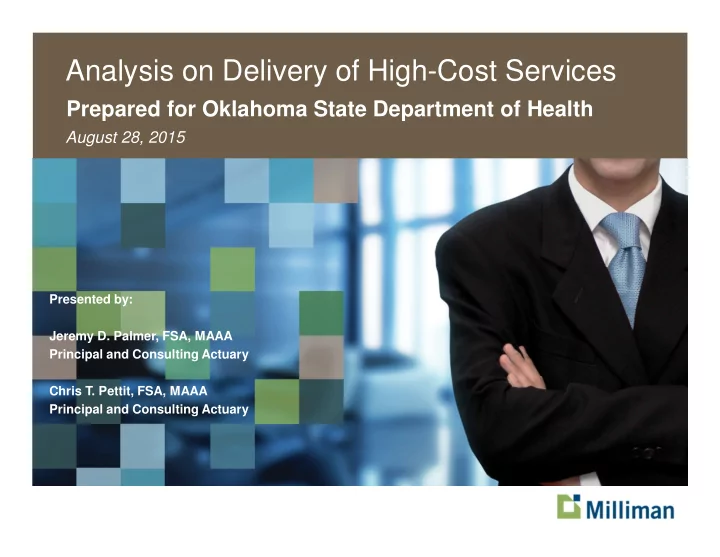

Analysis on Delivery of High-Cost Services Prepared for Oklahoma State Department of Health August 28, 2015 Presented by: Jeremy D. Palmer, FSA, MAAA Principal and Consulting Actuary Chris T. Pettit, FSA, MAAA Principal and Consulting Actuary
Background Specific topics • Evaluate and categorize high-cost services requested in this • Compare cost of OSIM identified conditions across payers analysis include: • Provide summary on demographics of populations • Discuss the methodology for identifying the populations • Define inpatient/outpatient optimization • Provide cost of care based on operational benchmarks INTRODUCTION 2
Table of Contents A. Introduction and background B. High-cost individuals and conditions C. Cost of care and service types D. Optimization and operational benchmarks E. Methodology and assumptions F. Limitations and qualifications 3
Reference to full report This presentation is intended to supplement the full report which documents complete analysis and is titled: Oklahoma State Innovation Model: Delivery of High-Cost Services Discussion Draft August 26, 2015 4
High-cost services in the State of Oklahoma High- High- High- risk cost cost patients services patients • Key to identifying where high-cost services are being delivered is identifying who and where the high-cost patients are located • Analyze across multiple payers: Medicare, Medicaid, commercial • Fosters path to meeting OSIM-defined goals: • Reduce healthcare expenditures • Provide better quality of care • Improve health outcomes INTRODUCTION AND BACKGROUND 5
80/20 rule on healthcare expenditures 100% 90% 80% Percentage of medical expenditures 70% 60% 50% 40% 30% 20% 10% 0% 0% 10% 20% 30% 40% 50% 60% 70% 80% 90% ���������������������� • 80% of healthcare expenditures are for services/procedures performed on 20% of population • Highlights need to focus on a smaller portion of the population • Can gain the most by focusing on smaller group of individuals with bigger return on invested resources HIGH-COST INDIVIDUALS 6
Spend by category of service Average patient Highest cost patients HIGH-COST INDIVIDUALS 7
OSIM identified conditions • Phase 1 of OSIM plans requests population-based health measures for selected health topics: • Obesity • Diabetes • Hypertension • Tobacco usage • ICD-9 codes to identify through claims information, where available • Proxy morbidities utilized for conditions under reported ������������������ ������������������������������� � ����������� ��������� ��������� ����� � ����� � ��� � �������� ���� � ����� � ���� � ��������� ������������� ����� � ����� � ���� � ����� � �������������� � Prevalence rates for obesity and tobacco were not based on claims information due to under reporting HIGH-COST CONDITIONS 8
Insurance market overview Commercial Medicare Medicaid • Employer- • Age and health • Income-based sponsored status eligibility eligibility • Market-based • Member • Little enrollee benefits premiums and cost exposure exposure to • Oklahoma • State and cost-sharing enrollment federally 800k in 2013 • Federal operated government • Oklahoma • Oklahoma enrollment enrollment 800k in 2014 625k in 2013 • Analyze high-cost conditions across all three markets • Important to treat each population differently based on coverage COST OF CARE 9
Total cost of care $30,000 $25,000 $20,000 $15,000 Commercial $10,000 Medicare Medicaid $5,000 $0 • Highlights disparity in cost of the composite population against analyzed conditions • Does not include all healthcare dollars spent on patients – no Medicare Part D • Medicaid report information not available for obesity and tobacco use COST OF CARE 10
Relative cost of conditions ������������������ ���������������������������������� � ����������� ��������� ��������� �������� ����� ����� !"� ��������� ����� ����� ����� ������������� ����� ����� ����� �������������� ����� ����� !"� #������$��%&������ ����� ����� ����� "'������"��%�&�(���� )�*���� )��*���� )�*���� � • Relative value calculated as condition-specific PMPY over average annual cost • Medicare summarized costs did not include pharmacy spend • Medicaid information derived from OHCA provided studies/reports • Relative value of conditions indicates patients are 2 to 3 times more expensive than average patient • Medicaid experience excludes nursing facility expenditures and enrollment COST OF CARE 11
Types of services $18,000 $16,000 $14,000 $12,000 Ancillaries $10,000 Pharmacy $8,000 $6,000 Professional $4,000 Hospital Outpatient $2,000 Hospital Inpatient $0 • Distribution of services does not vary significantly as observed in highest cost members, but facility spending on high-cost conditions is greater than average • Actuarial cost models included in report detail cost by category • Based on commercial experience TYPES OF SERVICES 12
Degree of healthcare management Degree of healthcare management indicates portion of care that is being well-managed Loosely Well- managed managed Limited use of Minimal incentives Active use of Programs to educate evidence based to manage evidence-based physicians on practices treatment guidelines efficiency Limited use of low Excessive use of Financial incentives On-site utilization cost alternatives costly services rewarding providers management for efficiency Little promotion of Use of primary care change manager OPTIMIZATION AND OPERATIONAL BENCHMARKS 13
Calculating potential savings Commercial Population ��������� ���������� ���������� ���������� ����� ���������� ����������� ��������� ��������� ���� ������ ������� ���������� ���������� ������� ������� )�*��� ���� )��� ����� ���*��� )���+�&&��� �������� �*��� ���� ��� ���� ���*��� )��+�&&��� ������������ �*��� ���� ��� ����� ���*��� )���+�&&��� ������������� �*��� ���� ��� ����� ���*��� )���+�&&��� Medicaid Population • Estimate potential savings utilizing ��������� ���������� information detailed in ���������� ���������� ����� ���������� ��������� ��������� report ��������� ���� ������ ������� ���������� ���������� ������� • Focus on hospital ������� !" ���� !" ����� ���*��� !" inpatient costs �������� �*��� ���� )��� ���� ���*��� )��+�&&��� • Assumes reasonable ������������ �*��� ���� )�� ���� ���*��� )��+�&&��� DoHM improvement goals ������������� !" ���� !" ����� ���*��� !" OPTIMIZATION AND OPERATIONAL BENCHMARKS 14
Recommend
More recommend